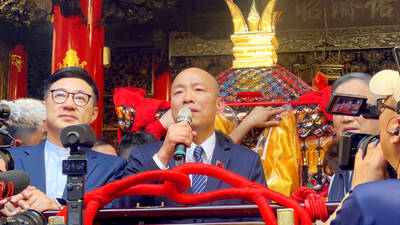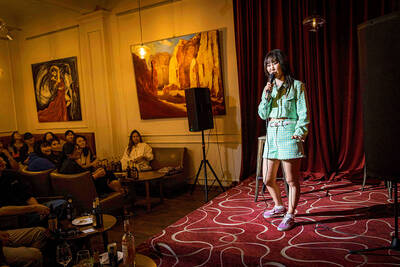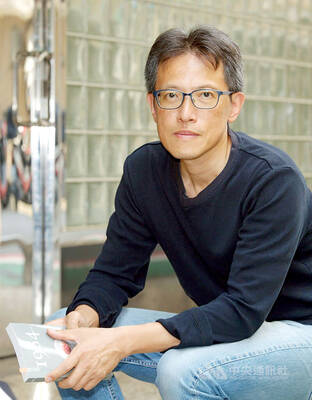Taiwan in Time: Dec. 26 to Jan. 1
It didn’t seem like much of a name change when Tamsui’s Mackay Hospital moved to Taipei and reopened as the Mackay Memorial Hospital on Dec. 26, 1912. However, the rechristening is much more significant than one might realize, as the original was actually named after a different Mackay.
The current namesake is Canadian missionary George Leslie Mackay, who opened the Mackay Hospital in 1880 as northern Taiwan’s first Western medical institution. He writes in his memoir, From Far Formosa that the clinic was named after Captain Mackay from Detroit, whose widow donated the US$3,000 to erect the building.

Photo: Huang Chi-hao, Taipei Times
The identical last name is likely just a coincidence, and no more information could be found about Captain Mackay. But what is worth exploring is the medical conditions in Taiwan during that time and why providing care was so important to Mackay’s missionary activities.
Chen Chih-jung (陳志榮) writes in the study Religion and Medical Treatment — Mackay’s Medical Missionary as a Case Study (宗教與醫療 -- 以馬偕醫療傳教為例) that while there were effective and competent traditional Chinese doctors in Taiwanese society during that time, the problem was that these services were limited. Figures from the Japanese government show that in 1897, out of a population of 2.5 million people, there were only 1,070 registered doctors.
In A Study of Medical Services in Taiwan Before the Japanese Era (日治時期前臺灣醫療發展之探討), Chang Chia-sheng (張加昇) and Su Yi-chang (蘇奕彰) write that the Qing government mostly left the management of medical services to local Taiwanese, leading to a lack of quality control. A doctor did not need a license to open a clinic, and it was hard to tell who was legitimate.

Photo: Weng Yu-huang, Taipei Times
Furthermore, Chang and Su write that many people were superstitious and preferred to pray to the gods or employ other religious means. Some even believed that overexertion of human effort to cure a disease was against the wishes of the gods and could lead to misfortune, leading to culture where people weren’t very proactive in seeking medical attention.
Missionaries have long provided medical services as a means of goodwill toward the natives, and Mackay writes that out of all his training, his medical studies proved the most practical.
“I found people suffering from various ailments and diseases, and the power to relieve their pain and heal their diseases won for the mission grateful friends and supporters,” he writes.
These attempts were not always successful. Chen writes that before Mackay, missionary James Maxwell arrived in Tainan in 1865 to offer free medical care. But just three weeks into his venture, rumors spread that Maxwell used sorcery to create medicine from dead bodies, and an angry mob destroyed his clinic.
Mackay writes that the most widespread disease when he arrived was malaria, which is quickly brought up in his introduction of Taiwan after its basic geography and climate.
“[Malaria] is the blackest cloud that hangs longest over our beautiful island,” he writes. “Because of it disease and death work terrible havoc among the inhabitants … Seldom do three months elapse without one or more members of every household being laid low.”
Locals believed that the disease was “caused by the patient unluckily treading on mock-money put in the street or on the roadside by a priest or sorcerer; or by a conflict between the hot and cold principles in nature; or by two devils, one belonging to the negative principle in nature, fanning the patient, thus causing the chills, and the other belonging to the positive principle, blowing a furnace and producing heat and fever.”
Along with treating malaria, Mackay also placed importance on dental work, as people were having problems due to malaria, cigar smoking or betel-nut chewing. He writes that he devised a gentler way of tooth extraction, personally extracting 21,000 teeth between 1873 and 1896.
His popularity increased quickly, from 1,346 new patients during the hospital’s first year in 1880 to 3,696 in 1890. The hospital closed after Mackay’s death in 1901, but reopened in 1907 before its move to Taipei.
And the effectiveness of his work? Mackay writes in his memoir, “Large numbers were cured during these 23 years, many more were relieved, and the services rendered made them much more kindly disposed toward the mission. Many became converts themselves, and their example told with their relatives and friends. The reflex influence of all this medical work cannot be estimated. The direct results in the conversion of patients cannot be told.”
Taiwan in Time, a column about Taiwan’s history that is published every Sunday, spotlights important or interesting events around the nation that have anniversaries this week.

Three big changes have transformed the landscape of Taiwan’s local patronage factions: Increasing Democratic Progressive Party (DPP) involvement, rising new factions and the Chinese Nationalist Party’s (KMT) significantly weakened control. GREEN FACTIONS It is said that “south of the Zhuoshui River (濁水溪), there is no blue-green divide,” meaning that from Yunlin County south there is no difference between KMT and DPP politicians. This is not always true, but there is more than a grain of truth to it. Traditionally, DPP factions are viewed as national entities, with their primary function to secure plum positions in the party and government. This is not unusual

Mongolian influencer Anudari Daarya looks effortlessly glamorous and carefree in her social media posts — but the classically trained pianist’s road to acceptance as a transgender artist has been anything but easy. She is one of a growing number of Mongolian LGBTQ youth challenging stereotypes and fighting for acceptance through media representation in the socially conservative country. LGBTQ Mongolians often hide their identities from their employers and colleagues for fear of discrimination, with a survey by the non-profit LGBT Centre Mongolia showing that only 20 percent of people felt comfortable coming out at work. Daarya, 25, said she has faced discrimination since she

April 21 to April 27 Hsieh Er’s (謝娥) political fortunes were rising fast after she got out of jail and joined the Chinese Nationalist Party (KMT) in December 1945. Not only did she hold key positions in various committees, she was elected the only woman on the Taipei City Council and headed to Nanjing in 1946 as the sole Taiwanese female representative to the National Constituent Assembly. With the support of first lady Soong May-ling (宋美齡), she started the Taipei Women’s Association and Taiwan Provincial Women’s Association, where she

More than 75 years after the publication of Nineteen Eighty-Four, the Orwellian phrase “Big Brother is watching you” has become so familiar to most of the Taiwanese public that even those who haven’t read the novel recognize it. That phrase has now been given a new look by amateur translator Tsiu Ing-sing (周盈成), who recently completed the first full Taiwanese translation of George Orwell’s dystopian classic. Tsiu — who completed the nearly 160,000-word project in his spare time over four years — said his goal was to “prove it possible” that foreign literature could be rendered in Taiwanese. The translation is part of